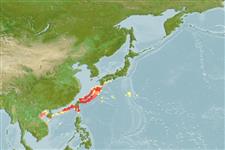>
Pleuronectiformes (Flatfishes) >
Cynoglossidae (Tonguefishes) > Symphurinae
Etymology: Symphurus: Greek, syn, symphysis = grown together + Greek, oura = tail (Ref. 45335); megasomus: Name derived from the Greek, 'mega' for large, and 'somus' for body, referring to the large size of this species and the deep body without obvious tapering in the posterior body..
Environment: milieu / climate zone / depth range / distribution range
Οικολογία
Θαλασσινό(ά) βενθοπελαγικό; εύρος βάθους 200 - 640 m (Ref. 82423). Subtropical
Κατανομή
Χώρες | Περιοχές FAO | Οικοσυστήματα | Παρουσίες | Point map | Εισαγωγές | Faunafri
Northwest Pacific: Taiwan.
Length at first maturity / Μέγεθος / Βάρος / Age
Maturity: Lm 12.3, range 10 - 14.342 cm
Max length : 14.7 cm SL αρσενικό/απροσδιόριστο; (Ref. 82423); 14.3 cm SL (female)
Short description
Μορφολογία | Μορφομετρία
Μαλακές ραχιαίες ακτίνες (συνολικά): 106-111; Μαλακές εδρικές ακτίνες: 91 - 96; Σπόνδυλοι: 55 - 58. This species is distinguished from all its congeners, except S. hondoensis and S. undatus, by its predominant 1-2-3-2-2 ID pattern. It also differs from both abovementioned species in having smaller eye (5.3-7.9% HL vs. 11.0-14.9% HL in S. hondoensis and 11.5-13.8% HL in S. undatus). This species further differs from S. hondoensis
in having 9 abdominal vertebrae (vs. 10). S. megasomus is also distinguished from S. undatus, by having higher fin-ray counts, 106-111 dorsal-fin rays and 91-96 anal-fin rays (vs. 101-105 dorsal-fin rays and 87-91 anal-fin rays) and a uniform straw-colored to dark brown ocular-side coloration (vs. freckled ocular-side pigmentation) (Ref. 82423).
This deep-water tonguefish species is known only from the continental shelf and upper continental slope off northeastern and eastern Taiwan; from 471-640 m by research vessels. Polychaetes, small crustaceans and some unidentified detritus were found in the digestive systems of fishes examined. Little else is known regarding the biology of this species (Ref. 82423).
Life cycle and mating behavior
Γεννητική Ωρίμανση | Αναπαραγωγή | Γεννοβολία | Αβγά | Γονιμότητα | Προνύμφες
Lee, M.-Y., H.-M. Chen and K.-T. Shao, 2009. A new species of deep-water tonguefish genus Symphurus (Pleuronectiformes: Cynoglossidae) from Taiwan. Copeia 2009(2):342-347. (Ref. 82423)
IUCN Red List Status (Ref. 130435)
Threat to humans
Harmless
Human uses
Περισσότερες πληροφορίες
ΧώρεςΠεριοχές FAOΟικοσυστήματαΠαρουσίεςΕισαγωγέςStocksΟικολογίαΔίαιταΤροφικά αντικείμεναΚατανάλωση τροφήςΣιτηρέσιο
Age/SizeΑύξησηLength-weightLength-lengthLength-frequenciesΜορφομετρίαΜορφολογίαΠρονύμφεςΔυναμική προνυμφώνΣτρατολόγησηΑφθονίαBRUVS
ΑναφορέςΥδατοκαλλιέργειεςΠροφίλ υδατοκαλλιέργειαςΣτελέχοιΓενετικήElectrophoresesΚληρονομικότηταΑσθένειεςΜεταποίησηNutrientsMass conversion
ΣυνεργάτεςΦωτογραφίεςStamps, Coins Misc.ΉχοιΣιγκουατέραΤαχύτηταΚολυμβητικός ΤύποςΕπιφάνεια βραγχίωνOtolithsΕγκέφαλοιΌραση
Εργαλεία
Special reports
Download XML
Διαδικτυακές πηγές
Estimates based on models
Preferred temperature (Ref.
123201): 9.6 - 16.7, mean 12.5 °C (based on 17 cells).
Phylogenetic diversity index (Ref.
82804): PD
50 = 0.5000 [Uniqueness, from 0.5 = low to 2.0 = high].
Bayesian length-weight: a=0.01445 (0.00647 - 0.03228), b=3.05 (2.85 - 3.25), in cm total length, based on LWR estimates for this (Sub)family-body shape (Ref.
93245).
Τροφικό Επίπεδο (Ref.
69278): 3.3 ±0.4 se; based on size and trophs of closest relatives
Ελαστικότητα (Ref.
120179): Υψηλό, ελάχιστος χρόνος για διπλασιασμό πληθυσμού < 15 μήνες (Preliminary K or Fecundity.).
Fishing Vulnerability (Ref.
59153): Low vulnerability (10 of 100).
